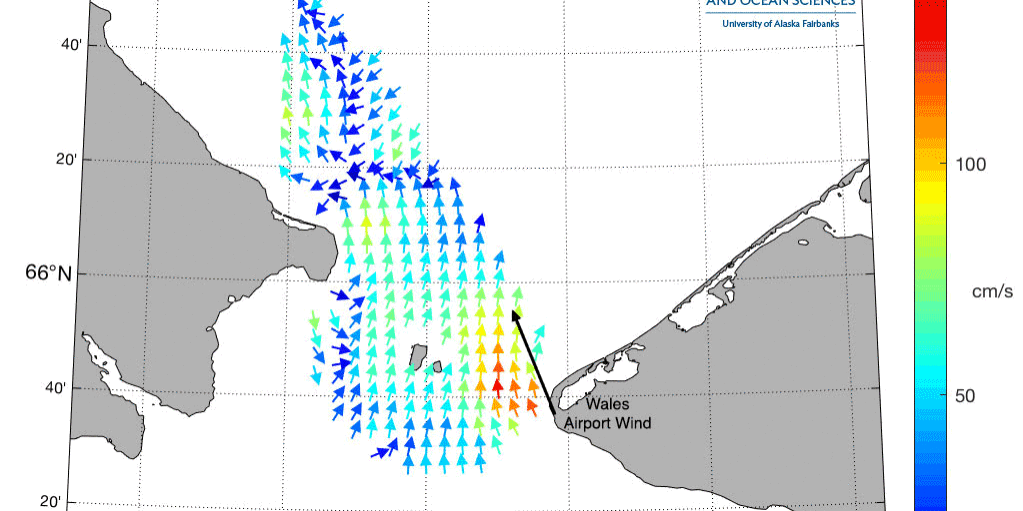New technology in Wales and Shishmaref that utilizes high frequency radar is collecting important data about the Bering Sea’s ocean currents. That data could help track debris, improve weather forecasts, and even save lives.
High frequency radars [HFR] capture data on ocean currents by transmitting radio waves that bounce off the ocean. The measurements show not only the direction of ocean currents, but also the speed.
“As you can imagine, there’s a number of different things that one might be able to imagine doing with data like this.”
– Seth Danielson
That’s Seth Danielson, associate professor at UAF and leader of the HFR project, giving project updates at a Strait Science presentation on January 7.
HFR technology can be used for many things, from tracking harmful algal blooms to improved efficiency for vessel operators. Danielson says that the ocean data is particularly helpful for public safety efforts.
“The US Coast Guard likes to have this type of data when they undertake search and rescue missions; especially for missing boaters, and other response-type efforts such as responding to oil spills, marine debris tracking, pollution responses …”
– Seth Danielson
In 2019, radar sites were installed in Wales and Shishmaref, which are the first sites to be installed in the region to gather data from the Bering Sea.
These regional radar sites are only testers, and therefore are not working at full capacity. Both locations were able to collect limited data in the fall of 2019 for ocean currents. While not yet in real-time, the data does show the direction and speed of currents on a map of the Bering Sea.
Currently, the Bering Strait Maintenance Department in Shishmaref helps power their local HFR site. And in Wales, Michael Ahkinga, Sr. helped the research team gather data. He says he helps keep the equipment up and running.
– Michael Ahkinga, Sr.
“When they need something done, if they have any kind of power issues, or if they have no readings, I do all the maintenance work; make sure they got power going to the system, maintain the antennas outside … I just do maintenance work around the area.
Danielson says the research team has been looking to improve the HFR sites, including gathering real-time data and moving the site at Wales closer to the coast.
“The site at Wales really has a big gap with weak returns both to the north and to the south of Wales, so we think that by moving that site along the coast will give us the opportunity to make a second map of radials and that will give us fuller coverage in the region and be just that much more useful for all the different applications of the data.”
-Seth Danielson
The HFR research team planned on making these improvements to the radar sites last year to collect more data. However in the spring of 2020, Danielson says they faced a familiar roadblock.
“And then last year as you all know, during the normal summer field season, all travel for research and all other activities was impossible due to COVID.”
– Seth Danielson
Luckily, the research team was able to gather data from the radar sites thanks to local volunteers like Ahkinga.
The technicians are ready to go with working on the improvements and relocation. Now they are simply waiting for the right weather and reduced travel restrictions.
The researchers are still looking for a point person in Shishmaref to help them gather data. If you are a local resident and want to help out, you can call Seth Danielson at 907-474-7834 or email him at sldanielson@alaska.edu.
More information on the project and previous ocean current data can be found here.
Image at top: Bering Strait surface currents recorded by the HFR site in Wales in fall 2019. Gif taken from UAF College of Fisheries and Ocean Sciences.




